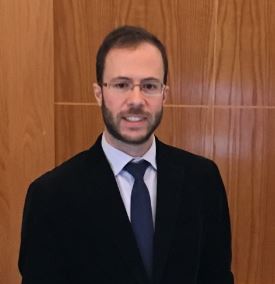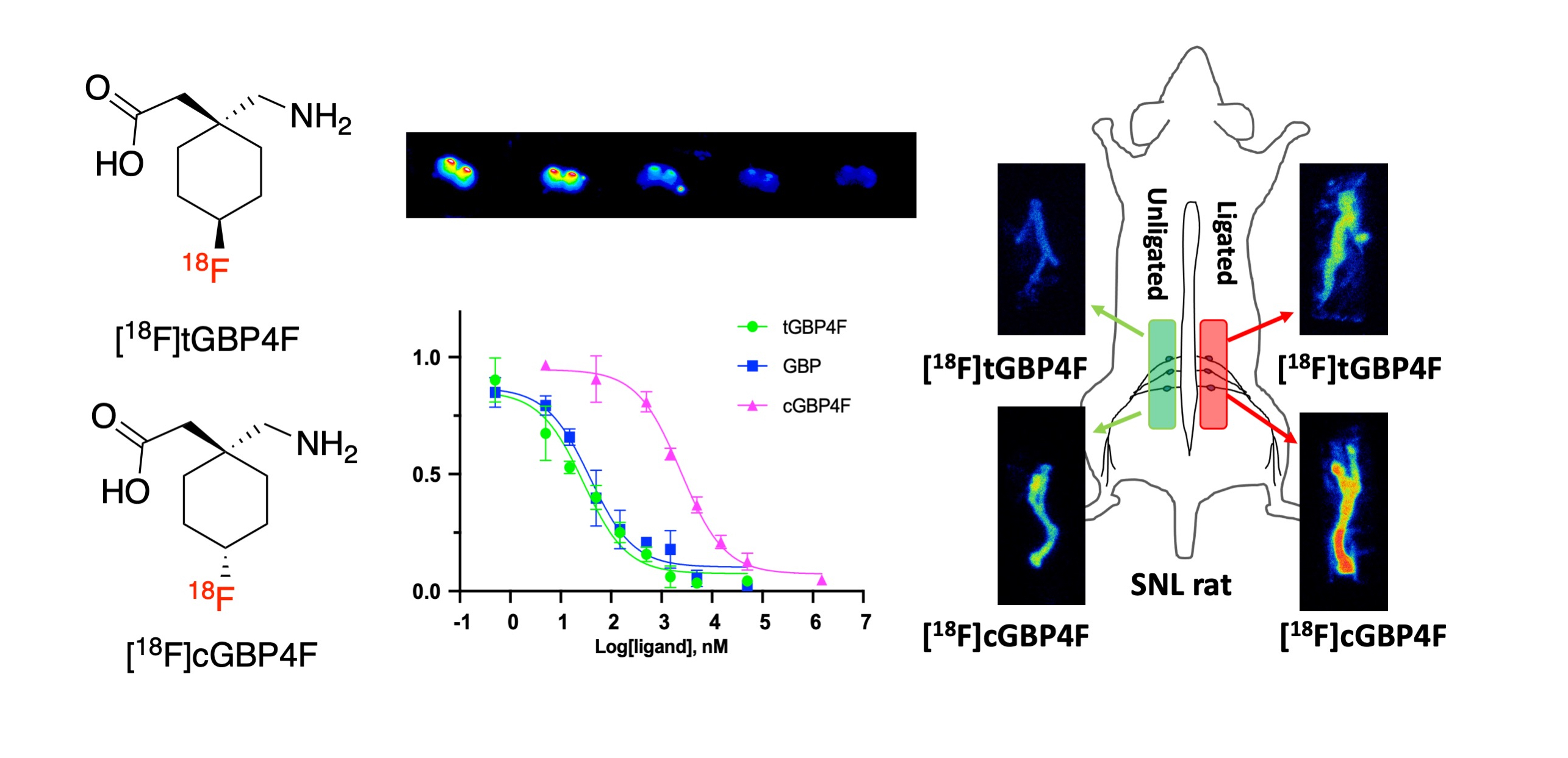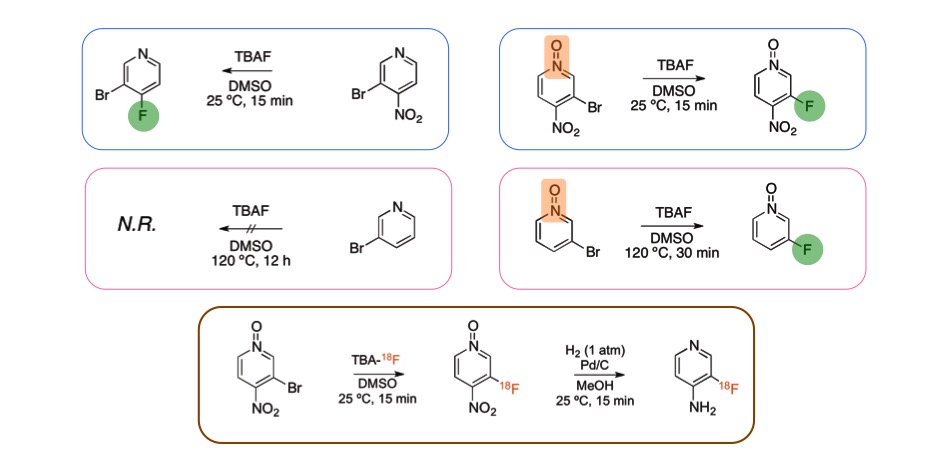Welcome to the Brugarolas lab
PEDRO BRUGAROLAS - RESEARCH - FUNDING - LAB MEMBERS - COLLABORATORS - NEWS - PUBLICATIONS - OPPORTUNITIES - CONTACT
 Welcome to the laboratory of Dr. Pedro Brugarolas at the Gordon Center for Medical Imaging
of Massachusetts General Hospital and Harvard Medical School.
The focus of our group is to develop new small molecule PET radioligands for neurological diseases and immunoPET. We are particularly interested in developing
tracers for potassium channels in the brain to image demyelinating diseases (see Developing a PET tracer for K⁺ channels) and
tracers for calcium channels to image neuropathic pain and epilepsy (see Developing PET tracers for Ca2+ channels).
Welcome to the laboratory of Dr. Pedro Brugarolas at the Gordon Center for Medical Imaging
of Massachusetts General Hospital and Harvard Medical School.
The focus of our group is to develop new small molecule PET radioligands for neurological diseases and immunoPET. We are particularly interested in developing
tracers for potassium channels in the brain to image demyelinating diseases (see Developing a PET tracer for K⁺ channels) and
tracers for calcium channels to image neuropathic pain and epilepsy (see Developing PET tracers for Ca2+ channels).
Back to top
PEDRO BRUGAROLAS
Assistant Professor of Radiology 1/2018 - present
Harvard Medical School, Boston, Massachusetts
Massachusetts General Hospital, Boston, Massachusetts Visiting Scientist, Radiochemistry 3/2017 - 6/2017
Mentor Victor W. Pike, National Institute of Mental Health, National Institutes of Health, Bethesda, Maryland Postdoc, Neuroscience and PET 1/2012 - 2/2017
Mentor Brian Popko, Department of Neurology, The University of Chicago, Chicago, Illinois Ph.D. in Chemistry 9/2006 - 12/2011
Advisor Chuan He, Department of Chemistry, The University of Chicago, Chicago, Illinois B.E. in Computer Science 12/2008
Universidad Nacional de Educacion a Distancia - UNED, Madrid, Spain B.S. in Chemistry 6/2005
University of Alicante, Alicante, Spain
Back to top
RESEARCH SUMMARY
1. DEVELOPING A PET TRACER FOR VOLTAGE-GATED POTASSIUM CHANNELS
This work is partially funded by the NIH/NINDS, the Polsky Center for Entrepreneurship and Innovation and an MGH ECOR Physician and/or Scientist Development Award to Dr. Ramos-Torres
Potassium (K⁺) channels in myelinated axons are normally buried beneath the myelin sheath. During MS and other demyelinating conditions such as traumatic brain injury and stroke, myelin becomes damaged leaving these channels exposed, which results in leakage of intracellular K⁺ ions and disruption of axonal conduction of action potentials. Consequently, K⁺ channel blockers, such as 4-aminopyridine, have been exploited clinically to enhance axonal conduction and improve neurological function in patients with MS. We recently showed that K⁺ channels can be targeted for imaging demyelinated lesions in animal models of demyelination and are currently evaluating this tracer in humans. See ClinicalTrials.gov record for more information.

Back to top
2. DEVELOPING PET TRACERS FOR THE ALPHA2DELTA-1 SUBUNIT OF VOLTAGE-DEPENDENT CALCIUM CHANNELS
This work is funded by the NIH/NINDS and a K99 award from NIH/NIBIB to Dr. Zhou
Pain and seizure disorders affect millions of people worldwide. Non-invasive imaging of these conditions is critical for their diagnosis and clinical management. Current imaging methods use a combination of techniques including MRI, [18F]FDG PET and SPECT, which lack specificity. One feature shared by pain and seizure disorders is that the expression of certain calcium (Ca2+) channels is altered in the disease focus. As such, imaging the alpha2delta-1 subunit of voltage-dependent Ca2+ channels by PET may provide a new window into the pathology.

Back to top
3. DEVELOPING A NON-COVALENT PRETARGETING APPROACH TO IMMUNO PET
This work is funded by the NIH/NIBIB
Therapeutic monoclonal antibodies comprise a multibilion dollar market. Just like any other therapeutic, these drugs do not work for every patient. Data from clinical trials shows responses between 15% and 60% for most therapeutic antibodies. Recent studies suggest that localization of the antibody is a good predictor of response. In this project, we are trying to develop a new way to image monoclonal antibodies using small molecule PET radioligands.
Back to top
4. NEW FLUORINATION AND RADIOFLUORINATION STRATEGIES
Due to their electron-rich aromatic structure nucleophilic fluorination of pyridines is challenging, especially at the meta position. Current strategies for radiofluorination ofter require difficult to make precursors. In this project, we discovered that pyridine N-oxides which are easy to make and often commercially available can be excellent precursors. Furthermore, fluorination occurs quickly at room temperature.

Back to top
FUNDING
Current
Can [18F]3F4AP detect brain demyelination? Evaluation of novel PET tracer in nonhuman primates and humans. 12/2019 - 11/2024
NIH/NINDS R01NS114066
(PI)
NIH/NIBIB R56NS029259
Brugarolas (subaward PI), J. Wilson, Cornell University (Prime PI)
Demyelination in the injured human spinal cord. 4/2020 - 3/2023 (NCE)
E.R. & M.J. Gordon Center for the Cure and Treatment of Paralysis
Brugarolas (coinvestigator), Linnman (PI)
3F4AP: a new PET tracer for multiple sclerosis. 1/2018 - completion
Innovation Fund Award - Polsky Center For Entrepreneurship and Innovation at The University of Chicago
(coPI with Brian Popko) Developing a PET-based method to assess myelination-promoting treatments. 7/2021 - 6/2023 (NCE)
Research Grant. Translational Research Program, Boston Children's Hospital
(coPI with Zhigang He)
Past
Development of a PET radiotracer for alpha2delta-1 receptors to visualize and quantify neuropathic pain mechanisms. 10/2020 - 5/2023
NIH/NINDS R21NS120139
(PI)
NIH/NIBIB R00EB020075 (PI)
New tools for imaging: diagnostics based on therapeutics. 7/2015 - 6/2017
NIH/NIBIB K99EB020075 (PI)
Fluorinated 4-aminopyridines for therapy and diagnosis of multiple sclerosis. 4/2014 - 3/2016
NIH/NINDS R21NS084382. (Coinvestigator, PI: B. Popko)
Development and characterization of fluorinated 4-aminopyridine analogs for therapy and PET imaging in multiple sclerosis. 10/2012 - 9/2014
National Multiple Sclerosis Society Pilot Research Award (Coinvestigator, PI: B. Popko)
Back to top
LAB MEMBERS
Karla M. Ramos Torres, PhD Instructor
PhD in Chemistry, University of California, Berkeley, CA, 2016
PhD in Chemistry, Technische Universität Berline, Berlin, Germany, 2018 Yang Sun, PhD Postdoctoral Fellow
PhD in Chemistry, École Polytechnique Fédérale de Lausanne, Switzerland, 2019 Lauren Zhang Undergraduate Researcher
Harvard College, Class of 2024 FORMER MEMBERS: Katarina J. Makaravage, PhD Postdoctoral Fellow, 5/2019-10/2020
PhD in Chemistry, University of Michigan, Ann Arbor, MI, 2019
Currently: Staff Scientist at Syngenta, NC Alyssa D. Bravin Undergraduate Researcher
Harvard College, Class of 2020
Back to top
COLLABORATORS
Marc D. Normandin, PhD
Associate Professor, Department of Radiology, GCMI, MGH
Assistant Professor, Department of Radiology, GCMI, MGH Kazue Takahashi, PhD
Assistant Professor, Department of Radiology, GCMI, MGH Eric C. Klawiter, MD
Director, Multiple Sclerosis and Neuromyelitis Optica Unit
Associate Professor, Department of Neurology, MGH Clas Linnman, PhD
Assistant Professor, Department of Physical Medicine and Rehabilitation, Spaulding Rehabilitation Hospital
Back to top
NEWS
June, 2023: Yu-Peng Zhou promoted to Instructor. Congratulations, Yu-Peng! Oct., 2022: We published the results from the first human study with [18F]3F4AP in the European Journal of Nuclear Medicine and Molecular Imaging! Article Sept., 2022: Nicolas Guehl presents initial results in from the first [18F]3F4AP study in multiple sclerosis patients! Abstract Aug., 2022: Yu-Peng receives a K99 award from NIBIB to develop second generation tracers for α2δ-1. Congratulations, Yu-Peng! July, 2022: Karla Ramos-Torres promoted to Instructor. Congratulations, Karla! July, 2021: Pedro receives the Jordi Folch-Pi Award from The American Society for Neurochemistry. April, 2021: Karla Ramos-Torres receives a Physician and/or Scientists Development Award from MGH ECOR. Congratulations, Karla! Jan., 2021: Welcome Yang Sun to the group! Dec., 2020: We received IND and IRB approval to begin studies with [18F]3F4AP in human subjects! Sept., 2020: Our R21 to develop a novel tracer for neuropathic pain has been selected for funding by the NIH/NINDS July, 2020: Karla's and Katarina's abstracts highlighted at the SNMMI Basic Summary Session. Congratulations! Nov., 2019: Yu-Peng receives a Tosteson & Fund for Medical Discovery Fellowship from MGH ECOR. Congratulations, Yu-Peng! March, 2019: TED-Ed video: Using radioactive drugs to see inside your body [watch video]
Back to top
PUBLICATIONS
Preprints
32. K.M. Ramos-Torres, Y. Sun, K. Takahashi, Y.P. Zhou and P. Brugarolas*. Common anesthetic used in preclinical PET imaging inhibits metabolism of the PET tracer [18F]3F4AP. bioRxiv, DOI: 10.1101/2023.12.14.571690, 2023.
31. Y. Sun, S. Rodriguez-Rangel, L. Zhang, J.E. Sanchez-Rodriguez* and P. Brugarolas*. Chemical and biophysical characterization of novel potassium channel blocker 3-fluoro-5-methylpyridin-4-amine. bioRxiv, DOI: 10.1101/2023.08.08.550404, 2023. 30. Y.P. Zhou, M.Q. Wilks, M. Dhaynaut, N.J. Guehl, S.H. Moon, G. El Fakhri, M.D. Normandin* and P. Brugarolas*. Radiosynthesis automation, non-human primate biodistribution and dosimetry of K⁺ channel tracer [11C]3MeO4AP. bioRxiv, DOI: 10.1101/2023.03.28.534386, 2023.Journal articles
29. Y. Zhou, M.D. Normandin, V. Belov,M.T. Macdonald-Soccorso, S.H. Moon, Y. Sun, G. El Fakhri, N.J. Guehl* and P. Brugarolas* Evaluation of trans- and cis-4-[18F]fluorogabapentin for brain PET imaging. ACS Chem. Neurosci., DOI: 10.1021/acschemneuro.3c00593 2023.
28. Y. Sun, K.M. Ramos-Torres and P. Brugarolas*. Metabolic Stability of the Demyelination PET Tracer [18F]3F4AP and Identification of its Metabolites. J. Pharmacol. Exp. Ther. 386(1):93-101, 2023. 27. S. Telu*, S. Jana, M.B. Haskali, B.Y. Yang, J. Jakobsson, Q. Zhao, K.M. Ramos-Torres, P. Brugarolas and V.W Pike* Broad-scope syntheses of [11C/[11F] trifluoromethylarenes from aryl(mesityl)iodonium salts. Chem. Eur. J. 29, e202204004. 2023. 26. P. Brugarolas*, M.Q. Wilks, J. Noel, J.A. Kaiser, D.R. Vesper, K.M. Ramos-Torres, N.J. Guehl, M.T. Macdonald-Soccorso, Y. Sun, P.A. Rice, D.L. Yokell, R. Lim, M.D. Normandin and G. El Fakhri*. Human biodistribution and radiation dosimetry of the demyelination tracer [18F]3F4AP. Eur. J. Nuc. Med. Mol. Imag. 50, 344-51, 2023. 25. Y. Sun, N.J. Guehl, Y.P. Zhou, V. Belov, K. Takahashi, M. Dhaynaut, S.H. Moon, G. El Fakhri, M.D. Normandin and P. Brugarolas*. Radiochemical Synthesis and Evaluation of 3-[11C]methyl-4-aminopyridine in Rodents and Non-Human Primates for Imaging Potassium Channels in the CNS. ACS Chem. Neurosci. 13, 23, 3342-51, 2022. 24. Y.P. Zhou, Y. Sun, K. Takahashi, V. Belov, N. Andrews, C.J. Woolf and P. Brugarolas*. Development of a PET radioligand for α2δ-1 subunit of calcium channels for imaging neuropathic pain. Eur. J. Med. Chem. 242:114688, 2022. 23. F.J. Detmer, N.M. Alpert, S.H. Moon, M. Dhaynaut, J.L. Guerrero, N.J. Guehl, F. Xing,P. Brugarolas, T.M. Shoup, M.D. Normandin, M. Pelletier-Galarneau, G. El Fakhri* and Y. Petibon*. PET imaging of mitochondrial function in acute doxorubicin-induced cardiotoxicity: a proof-of-principle study. Sci. Rep. 12:6122, 2022. 22. Y.P. Zhou, K.J. Makaravage and P. Brugarolas*. Radiolabeling with [11C]HCN for positron emission tomography. Nuc. Med. Biol. 102-3:56-86, 2021. 21. N.J. Guehl, R. Neelamegam, Y. Zhou, S.H. Moon, M. Dhaynaut, G. El Fakhri, M.D. Normandin* and P. Brugarolas*. Radiochemical Synthesis and Evaluation in Nonhuman Primates of 3-[11C]methoxy-4-aminopyridine: a novel PET tracer for Imaging Potassium Channels in the CNS. ACS Chem. Neurosci. 12(4):756-765, 2021. 20. T.M. Shoup, A. Griciuc, M.D. Normandin, L. Quinti, L.V. Walsh, M. Dhaynaut, S. Moon, N.J. Guehl, P. Brugarolas, D.R. Elmaleh*, G. El Fakhri* and R.E. Tanzi. Evaluation of Fluorinated Cromolyn Derivatives as Potential Therapeutics for Alzheimer’s Disease. J. Alzheimer's Dis. 80(2):775-786, 2021. 19. N.J. Guehl, K.M. Ramos-Torres, C. Linnman, S. Moon, M. Dhaynaut, M.Q. Wilks, P.K. Han, C. Ma, R. Neelamegam, Y. Zhou, B. Popko, J.A. Correia, D.S. Reich, G. El Fakhri, P. Herscovitch, M.D. Normandin* and P. Brugarolas*. Evaluation of the potassium channel tracer [18F]3F4AP in rhesus macaques. J. Cereb. Blood Flow Metab. 41(7):1721-1733, 2021. 18. K.M. Ramos-Torres, Y. Zhou, B. Yang, N.J. Guehl, S. Moon, S. Telu, M.D. Normandin, V.W Pike* and P Brugarolas*. Syntheses of [11C]2- and [11C]3-trifluoromethyl-4-aminopyridine: potential PET radioligands for demyelinating diseases. RSC Med. Chem. 11, 1161-1167, 2020. 17. S. Foxley*, G. Wildenberg, V. Sampathkumar, G.S. Karczmar, P. Brugarolas and N. Kasthuri. Sensitivity to myelin using model-free analysis of the water resonance line-shape in postmortem mouse brain. Magn. Reson. Imaging 85: 667–677, 2020. 16. P. Brugarolas, J. Comstock, D.W. Dick, T. Ellmer, J.W. Engle, S.E. Lapi, S.H. Liang, E.E. Parent, N.V.K. Pillarsetty, S. Selivanova, X. Sun, A. Vavere and P.J.H. Scott*, SNMMI RPSC Council. Fifty Years of Radiopharmaceuticals. J. Nucl. Med. Technol. 48(Suppl 1), 34S-39S, 2020. 15. S. Rodríguez-Rangel, A.D. Bravin, K.M.Ramos-Torres, P. Brugarolas* and J.E. Sánchez-Rodríguez* Structure-activity relationship studies of four novel 4-aminopyridine K⁺ channel blockers. Sci. Rep. 10(1), 52, 2020. 14. P. Brugarolas*, D.S. Reich and B. Popko. Detecting Demyelination by PET: The Lesion as Imaging Target. Mol. Imaging, 17:1536012118785471, 2018. 13. B. Elbaz, J.D. Aaker, S. Isaac, A. Kolarzyk, P. Brugarolas, A. Eden and B. Popko* Phosphorylation State of ZFP24 Controls Oligodendrocyte Differentiation. Cell Rep. 23(8), 2254-2263, 2018 12. P. Brugarolas*, J.E. Sánchez-Rodríguez, H.M. Tsai, F. Basuli, S.H. Cheng, X. Zhang, A.V. Caprariello, J. Lacroix, R. Freifelder, D. Murali, O. DeJesus, R.H. Miller, R.E. Swenson, C.T. Chen, P. Herscovitch, D.S. Reich, F. Bezanilla and B. Popko.* Development of a PET radioligand for potassium channels to image CNS demyelination. Sci. Rep. 8, 607, 2018. 11. F. Basuli*, X. Zhang, P. Brugarolas, D.S. Reich and R.E. Swenson. An efficient new method for the synthesis of [18F]3-fluoro-4-aminopyridine via Yamada-Curtius rearrangement. J. Labelled. Comp. Radiopharm. 61(2):112-117, 2018. 10. P. Brugarolas*, M. Bhuiyan, A. Kucharski and R. Freifelder. Automated radiochemical synthesis of [18F]3F4AP: a novel PET tracer for imaging demyelinating diseases. J. Vis. Exp. (123): 55537, 2016. 9. P. Brugarolas*, R. Freifelder, S.H. Cheng and O. DeJesus. Synthesis of meta-substituted [18F]3-fluoro-4-aminopyridine via direct radiofluorination of pyridine N-oxides. Chem. Commun. 52, 7150-2, 2016.8. S. Way, J. Podojil, B. Clayton, A. Zaremba, T. Collins, R. Kunjamma, A. Robinson, P. Brugarolas, R. Miller, S. Miller and B. Popko*. Pharmaceutical integrated stress response enhancement protects oligodendrocytes and provides a potential multiple sclerosis therapeutic. Nat. Commun. 6, 6532, 2015.
7. P. Brugarolas and B. Popko*. Remyelination therapy goes to trial for multiple sclerosis. Neurol. Neuroimmunol. Neuroinflamm. 1(2):e26, 2014.
6. Q. Ji, L. Zhang, M.B. Jones, F. Sun, X. Deng, H. Liang, H. Cho, P. Brugarolas, Y.N. Gao, S.N. Peterson, L. Lan, T. Bae and C. He*. Molecular mechanism of quinone signaling mediated through S-quinonization of a YodB family repressor QsrR. Proc. Natl. Acad. Sci. U. S. A. 110(13):5010-5, 2013.
5. P. Brugarolas, F. Movahedzadeh, Y. Wang, N. Zhang, I.L. Bartek, Y.N. Gao, M.I. Voskuil, S.G. Franzblau and C. He*. The oxidation-sensing regulator (MosR) is a new redox-dependent transcription factor in Mycobacterium tuberculosis. J. Biol. Chem. 287(45):37703-12, 2012.
4. B.P. Aryal, P. Brugarolas and C. He*. Binding of ReO4 with an engineered MoO4-binding protein: towards a new approach in radiopharmaceutical applications. J. Biol. Inorg. Chem. 17(1):97-106, 2012.
3. P. Brugarolas, E.M. Duguid, W. Zhang, C.B. Poor and C. He*. Structural and biochemical characterization of N5-carboxyaminoimidazole ribonucleotide synthetase and N5-carboxyaminoimidazole ribonucleotide mutase from Staphylococcus aureus. Acta Crystallogr. D Biol. Crystallogr. 67(8):707-15, 2011.
2. P.R. Chen, P. Brugarolas and C. He*. Redox signaling in human pathogens. Antioxid. Redox Signal. 14(6):1107-18, 2011.
1. J. García-Martínez*, P. Brugarolas and S. Domínguez-Domínguez. Ordered circular mesoporosity induced by phospholipids. Micropor. Mesopor. Materials. 100(1-3): 63-69, 2007.
Back to top
PATENTS
3. U.S. Patent Application: PCT/US2021/028455. Fluorinated derivatives of gabapentin and methods of use thereof. Inventor: P. Brugarolas, Y. Zhou. Priority date 4/2020. Patent Pending. [Patentscope]
2. U.S. Patent: US10160695B2. Synthesis of meta-substituted [18F]3-fluoro-4-aminopyridines by direct radiofluorination of pyridine N-oxides. Inventor: P. Brugarolas. Priority date 4/2016. Licensed by Fuzionaire Diagnostics Dec. 2020. [GooglePatents]1. U.S. Patents: US9617215B2 and US10442767B2. Use of fluorinated derivatives of 4-aminopyridine in therapeutics and medical imaging. Inventors: P. Brugarolas, B. Popko, D. Appelbaum, C.T. Chen. Priority date 5/2012. Licensed by Fuzionaire Diagnostics Dec. 2020. [GooglePatents] [GooglePatents2]
Back to top
INVITED TALKS
12/2022 "Development of PET radioligands for multiple sclerosis and other diseases”. Radiology Grand Rounds, University of Rochester School of Medicine, Rochester, NY.
11/2022 "Making new PET tracers for brain imaging and developing new (radio)chemistry along the way”. Bilkent Chemistry Seminar Series, Chemistry Department, Bilkent University, Ankara, Turkey. 10/2022 "Development and evaluation of novel PET tracers for neurological diseases”. Global R&D Seminar, GE Healthcare. 10/2022 "4-aminopyridine: Performing New Tricks with an Old Drug”. Presentation for Myro Therapeutics, Boston, MA. 11/2021 "Development of PET radioligands for multiple sclerosis and other diseases”. Department of Nuclear Medicine, Clínica Universitaria de Navarra, Pamplona, Spain. 5/2021 "Development of PET radioligands for multiple sclerosis and other diseases”. Department of Medical Biochemistry and Biophysics, Umeå University, Umeå, Sweden. 10/2020 "Development and translation of [18F]3F4AP: a novel PET tracer for demyelinating diseases”. Department of Radiology, Brigham and Women’s Hospital, Boston, MA. 4/2020 "Developing PET radiotracers for visualizing brain demyelination and other pathological processes”. Department of Radiology, Weill Cornell Medicine, New York, NY. 1/2020 "Developing PET Radiotracers for Brain Injuries, Pain and Other Diseases”. Department of Radiology, The University of Chicago, Chicago, IL.Back to top
OPPORTUNITIES
Postdoc Opportunties Available!
Email Dr. Brugarolas with CV, letter describing research background and interests, and contact info of three references.
CONTACT INFORMATION
Pedro Brugarolas, PhD
Updated 01/25/2024
Assistant Professor
Department of Radiology, Harvard Medical School
Gordon Center for Medical Imaging, Massachusetts General Hospital
55 Fruit St., Bulfinch 051
Boston, MA 02114
Tel. (617) 643-4574
E-mail: pbrugarolas AT mgh DOT harvard DOT edu
Twitter: @P_Brugarolas
